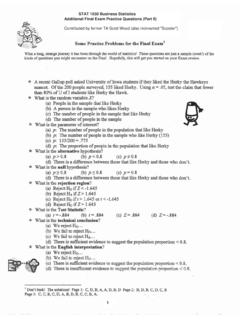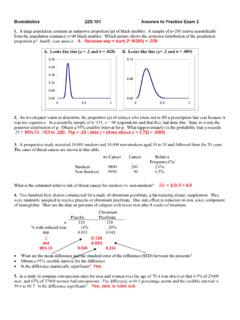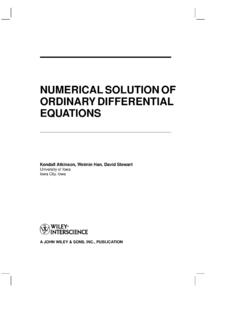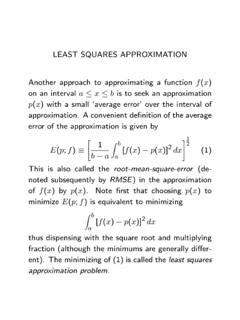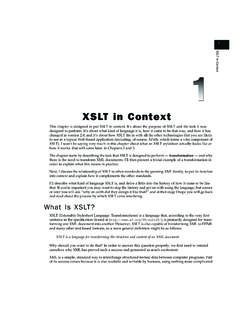Transcription of XSL Transformations - University of Iowa
1 XSLTC opyright 2006 by Ken Slonneger1 XSL TransformationsPreviously we used DOM and SAX to extract data from anXML document and present that information as plain text, asHTML, or organized in a new XML supplies another way to perform these kinds of (Extensible Stylesheet Language) is an application ofXML that provides tools for transforming an XML documentinto some other textual of xslt XSL is written entirely in XML. Its elements are found in a namespace with the URI" ". XSL is a declarative programming language: we describewhat we want, but we do not prescribe how to get takes the same approach to programming. It is complete programming language with variables,methods, and parameters but no assignment command tochange the value of a variable. The result of a transformation will be another XMLdocument, an HTML document, or a text document. The xslt processor parses the XML document toproduce a source tree that the transformation definitionworks on to produce a result tree.
2 xslt uses XPath expressions to specify nodes andvalues in the source 2006 by Ken SlonnegerXSLTXSLT ProcessStructure of an xslt Document<?xml version=" "?> <xsl:stylesheetversion=" "xmlns:xsl=" "> <!-- series of templates that match items in thesource tree and define the content to be placed inthe result tree --> </xsl:stylesheet>XSLTC opyright 2006 by Ken Slonneger3 Simple xslt ExamplesThe basic behavior of the xslt processor will be illustrated by aseries of simple examples that work on the XML a reminder, here is the structure of the elements found in thisdocument. Remember that the root of the source tree liesabove this xslt ProcessorBefore we are done, we will investigate several different toolsfor transforming an XML document using our first examples, we use a utility xsltproc that is availableon the Linux machines in the CS see the various options allowed by xsltproc try% man xsltprocWe invoke the program in two basic see the result document on the screen (standard output):% xsltproc 2006 by Ken SlonnegerXSLTTo put the result document into a file:% xsltproc -o result xsltproc >resultTwo Top-level ItemsIn our first example of an XSL program we have two differentitems at the top An instruction that tells the xslt processor to produce plaintext as its result (no XML declaration and no tags).
3 2. An example of a template rule, which has the following form<xsl:template match="XPath expression">Text and values to place in the result document.</xsl:template>In this first example we use the XPath expression "/" thatmatches the root of the source tree (not the root element).File: <?xml version=" "?> <!-- --> <xsl:stylesheet version=" " xmlns:xsl=" "> <xsl:output method="text"/> <xsl:template match="/"> Found the root of the source tree. </xsl:template> </xsl:stylesheet>XSLTC opyright 2006 by Ken Slonneger5 This style sheet matches the root with its template rule andsends the string "Found the root of the source tree." along withsome mysterious white space to the result the template rule has no instructions to continueprocessing the source tree, the string is all we : this style sheet we ask the xslt processor to continuelooking for matches in the source tree directly below thedocument root where the element phoneNumbers request is made by the empty element shown here.
4 <xsl:apply-templates/>The element xsl:apply-tempates always lies inside of atemplate rule. Its purpose is to direct the processor tocontinue down into the tree looking for templates to matcheach of the child nodes of the current node, the one thatmatched the enclosing template rule.<?xml version=" "?> <!-- --> <xsl:stylesheet version=" " xmlns:xsl=" "> <xsl:output method="text"/> <xsl:template match="/"> Found the root of the source tree. <xsl:apply-templates/> </xsl:template> <xsl:template match="phoneNumbers"> Found the phoneNumbers element. <xsl:apply-templates/> </xsl:template> <xsl:template match="title"> Found the title element. </xsl:template>6 Copyright 2006 by Ken SlonnegerXSLT <xsl:template match="entries"> Found the entries element. </xsl:template> </xsl:stylesheet>Observe that this style sheet continues processing in thetemplate rule that matches the element phoneNumbers andstops only when it reaches the elements title and to Found the root of the source tree.
5 Found the phoneNumbers element. Found the title element. Found the entries : this style sheet we add another element xsl:value-of, whichis used to extract or compute a value for the result select attribute specifies the value as an this particular example, the first xsl:value-of chooses thevalue of a child element of the current node and the secondchooses the current node itself using the abbreviation ".".The value of an element is the concatenation of all of thetextual content found inside of the element.<?xml version=" "?> <!-- --> <xsl:stylesheet version=" " xmlns:xsl=" "> <xsl:output method="text"/>XSLTC opyright 2006 by Ken Slonneger7 <xsl:template match="/"> Found the root of the source tree. <xsl:apply-templates/> </xsl:template> <xsl:template match="phoneNumbers"> Found the phoneNumbers element. Title1: <xsl:value-of select="title"/> <xsl:apply-templates/> </xsl:template> <xsl:template match="title"> Found the title element.
6 Title2: <xsl:value-of select="."/> </xsl:template> <xsl:template match="entries"> Found the entries element. <xsl:apply-templates/> <!-- investigate all children --> </xsl:template> <!-- of entries --> <xsl:template match="entry"> Found an entry element. </xsl:template> </xsl:stylesheet>Applying to Found the root of the source tree. Found the phoneNumbers element. Title1: Phone Numbers Found the title element. Title2: Phone Numbers Found the entries element. Found an entry 2006 by Ken SlonnegerXSLT Found an entry element. Found an entry element. Found an entry : this style sheet we reach down into the source tree fromthe root to specify a couple of particular values using XPathexpressions.<?xml version=" "?> <!-- --> <xsl:stylesheet version=" " xmlns:xsl=" "> <xsl:output method="text"/> <xsl:template match="/"> Phone: <xsl:value-ofselect="phoneNumbers/entries/entry/phone"/> City: <xsl:value-ofselect="phoneNumbers/entries/entry/city"/> </xsl:template> </xsl:stylesheet>Applying to Phone: 335-0055 City: Iowa CityXSLTC opyright 2006 by Ken Slonneger9 Two observations1.
7 Selecting an element in an xsl:value-of element choosesthe text found in the content of the selected The element xsl:value-of chooses only the first instance ofa node specified by the : element xsl:apply-templates allows an attribute selectthat directs the xslt processor to a certain set of nodes as itcontinues to use template rules to match this style sheet the first template points the processor tothe set of entry each of these nodes is matched, four lines of text aremoved to the result of the template that matches entry elements, thecurrent node or the context node is the entry element xsl:value-of elements select values of children of entry oran attribute that belongs to the name child of processing is directed to the name element so that itstemplate can extract two parts from each name.<?xml version=" "?> <!-- --> <xsl:stylesheet version=" " xmlns:xsl=" "> <xsl:output method="text"/> <xsl:template match="/"> <xsl:apply-templatesselect="phoneNumbers/entries/entry"/> </xsl:template>10 Copyright 2006 by Ken SlonnegerXSLT <xsl:template match="entry"> Name: <xsl:apply-templates select="name"/> Gender: <xsl:value-of select="name/@gender"/> Phone: <xsl:value-of select="phone"/> City: <xsl:value-of select="city"/> </xsl:template> <xsl:template match="name"> <xsl:value-of select="first"/> <xsl:value-of select="last"/> </xsl:template> </xsl:stylesheet>Applying to Name: RustyNail Gender: Phone: 335-0055 City: Iowa City Name: JustinCase Gender: male Phone: 354-9876 City: Coralville Name: PearlGates Gender: female Phone: 335-4582 City: North Liberty Name: HelenBack Gender: female Phone.
8 337-5967 City:Observe that there are no spaces between the first and lastnames. We deal with this problem the LogicIn the next example observe how changing the structure of thestylesheet alters the result 2006 by Ken Slonneger11 Instead of constructing a node set containing the entryelements and then processing their children, this next versionconstructs node sets with the name elements, the phoneelements, and then the city result document shows the same information, but in adifferent : <?xml version=" "?> <!-- --> <xsl:stylesheet version=" " xmlns:xsl=" "> <xsl:output method="text"/> <xsl:template match="/"> <xsl:apply-templatesselect="phoneNumbers/entries/entry/name"/> <xsl:apply-templatesselect="phoneNumbers/entries/entry/phone"/> <xsl:apply-templatesselect="phoneNumbers/entries/entry/city"/> </xsl:template> <xsl:template match="name"> Name: <xsl:value-of select="first"/> <xsl:value-of select="last"/> Gender: <xsl:value-of select="@gender"/> </xsl:template> <xsl:template match="phone"> Phone: <xsl:value-of select=".
9 "/> </xsl:template> <xsl:template match="city"> City: <xsl:value-of select="."/> </xsl:template> </xsl:stylesheet>12 Copyright 2006 by Ken SlonnegerXSLTA pplying to Name: RustyNail Gender: Name: JustinCase Gender: male Name: PearlGates Gender: female Name: HelenBack Gender: female Phone: 335-0055 Phone: 354-9876 Phone: 335-4582 Phone: 337-5967 City: Iowa City City: Coralville City: North LibertyAn ExperimentIn each of the previous examples, the style sheet has specifiedcarefully exactly which nodes to an experiment we delete the template rule that matches theroot and thereby omit the XPath expression that leads theprocessor to the entry : <?xml version=" "?> <!-- --> <xsl:stylesheet version=" " xmlns:xsl=" "> <xsl:output method="text"/>XSLTC opyright 2006 by Ken Slonneger13 <xsl:template match="entry"> Name: <xsl:apply-templates select="name"/> Gender: <xsl:value-of select="name/@gender"/> Phone: <xsl:value-of select="phone"/> City: <xsl:value-of select="city"/> </xsl:template> <xsl:template match="name"> <xsl:value-of select="first"/> <xsl:value-of select="last"/> </xsl:template> </xsl:stylesheet>Applying to Phone Numbers Name: RustyNail Gender: Phone: 335-0055 City: Iowa City Name: JustinCase Gender: male Phone: 354-9876 City: Coralville Name: PearlGates Gender: female Phone: 335-4582 City: North Liberty Name: HelenBack Gender: female Phone: 337-5967 City.
10 Observe that the xslt processor was still able to find the entryelements and apply the templates for entry and even found the content of the title element 2006 by Ken SlonnegerXSLTD efault Template RulesThe xslt processor always executes in an environment thatincludes a set of predefined template two template rules apply to the same node in a sourcetree, the processor chooses the more specific of the two. Thatis why the template rules in our examples have been when our style sheet has no template rule for a particularelement, the predefined default rules are next table show the behavior of the predefined Type RuleRoot Apply templates to childrenElementsApply templates to childrenText Copy text to result treeAttributes Copy value of attribute to result treeComments Do nothingProcessing instructionsDo nothingNamespace Do nothingFile: <?xml version=" "?> <!-- --> <xsl:stylesheet version=" " xmlns:xsl=" "> <xsl:output method="text"/> </xsl:stylesheet>XSLTC opyright 2006 by Ken Slonneger15 Applying to Phone Numbers Rusty Nail 335-0055 Iowa City Justin Case 354-9876 Coralville Pearl E.
